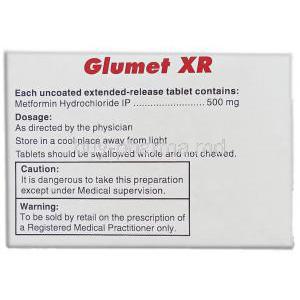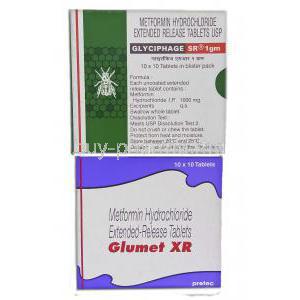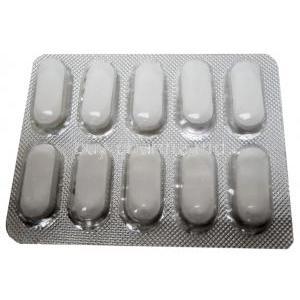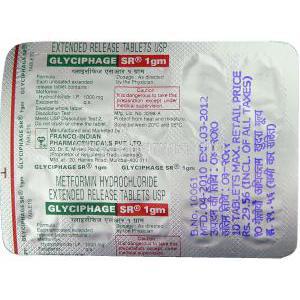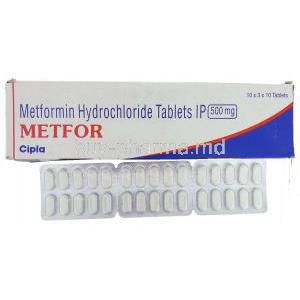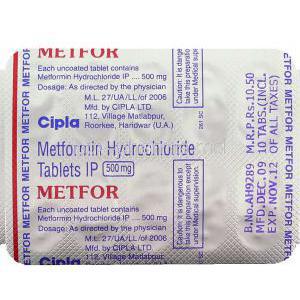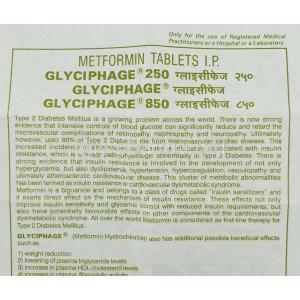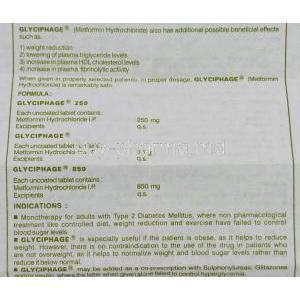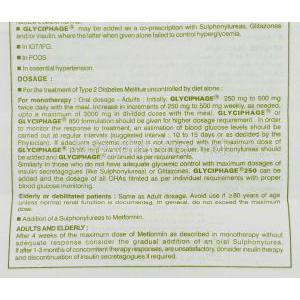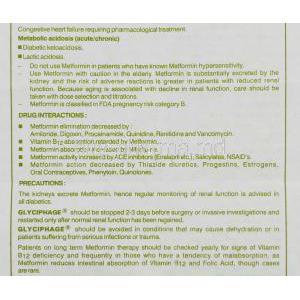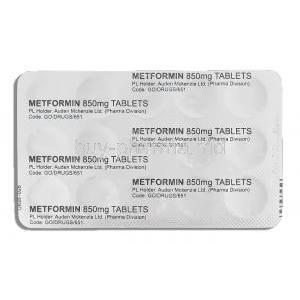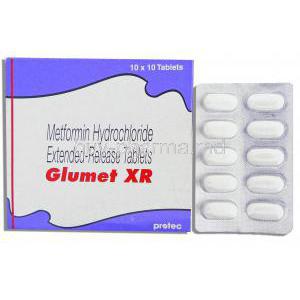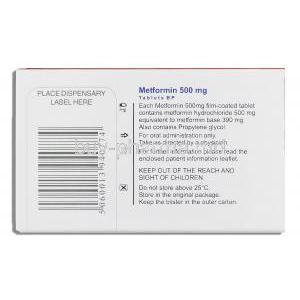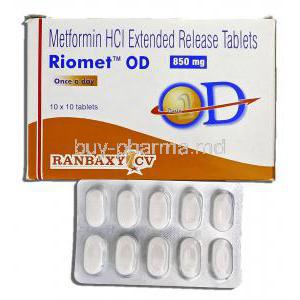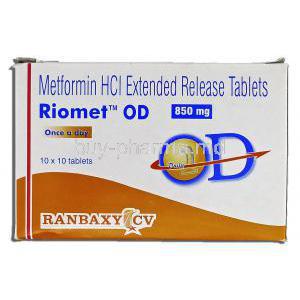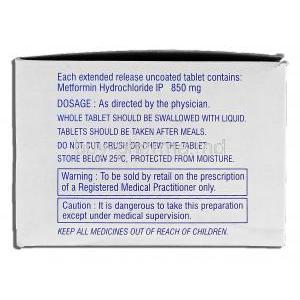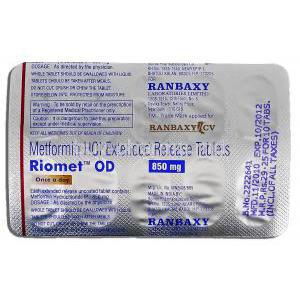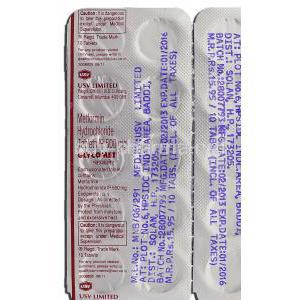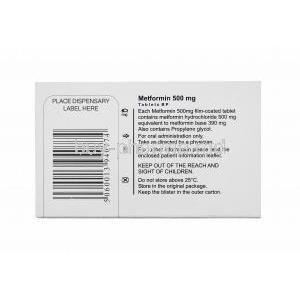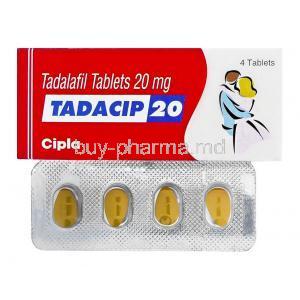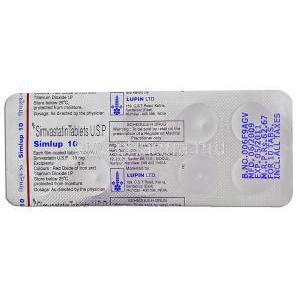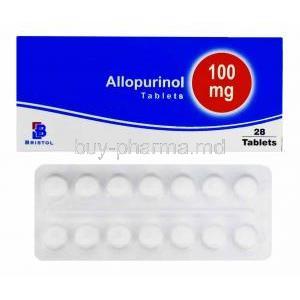Metformin
- I. Introduction
- II. Composition and Formulation
- III. How Metformin Works
- IV. Approved Uses of Metformin
- V. Off-Label Uses of Metformin
- VI. Dosage and Administration
- VII. Metformin Side Effects
- VIII. Interactions
- IX. Contraindications and Cautions
- X. Special Populations: Administration and Precautions
- XI. Overdosage
- XII. Storage and Handling Precactions
I. Introduction
A. Brief Overview of Metformin
Recognized as a primary weapon against Type 2 diabetes, Metformin displays remarkable efficacy and safety characteristics. This oral antihyperglycemic agent has long played a pivotal role in the management of diabetes by effectively lowering both basal and postprandial plasma glucose concentrations.
B. Historical Perspective and Development
It was derived from Galega officinalis, an herb historically known for its ability to lower blood sugar levels. The development of Metformin can be traced back to the 1920s. However, it wasn't until 1957 that Metformin received approval in the United Kingdom for treating Type 2 diabetes. Finally 1995, the drug was introduced in the United States and played a significant role in combating the worldwide diabetes crisis.
C. Role in Modern Medicine
Metformin has emerged as the preferred initial therapy for Type 2 diabetes due to its high efficacy, safety, affordability, and positive influence on cardiovascular morbidity. Furthermore, it has found utility in other medical areas besides diabetes, demonstrating potential in disorders like polycystic ovary syndrome (PCOS) and certain forms of cancer.
II. Composition and Formulation

A. Chemical Composition of Metformin
Metformin hydrochloride, known chemically as N,N dimethylimidodicarbonimidic diamide hydrochloride, is a crystalline compound that appears white or off-white. It has excellent solubility in water but is nearly insoluble in acetone, ether, and chloroform.
B. Different Formulations and Brands
Metformin is offered in different forms, such as immediate-release tablets, extended-release tablets, and oral solutions. Well-known brands include Glucophage, Glucophage XR, Glumetza, Fortamet, and Riomet. Although each brand may have slight variations in their inactive ingredients or delivery method, they all contain the main active ingredient, Metformin.
C. Analysis of Active and Inactive Ingredients
The therapeutic effect of the medication is attributed to its active ingredient, Metformin hydrochloride. On the other hand, inactive components like povidone, magnesium stearate, and hypromellose serve as fillers, binders, or facilitators of drug delivery. However, these inactive ingredients don't typically have any pharmacological effects. They play a vital role in the formulation and function of the drug.
III. How Metformin Works
A. Mechanism of Action
Metformin primarily works by decreasing hepatic glucose production, mainly through suppressing gluconeogenesis. Additionally, it increases insulin sensitivity by facilitating the uptake and utilization of glucose in peripheral tissues. Metformin carries out these actions without causing hypoglycemia—a joint adverse event associated with many anti-diabetic drugs available today.
B. Impact on Blood Sugar Levels
Metformin plays a significant role in regulating blood sugar levels. It achieves this by reducing the amount of glucose the liver produces and increasing glucose usage in the body. As a result, both fasting and postprandial blood glucose levels decrease, which helps prevent the harmful consequences of prolonged high blood sugar.
C. Benefits in Insulin Sensitivity and Beta-Cell Function
In addition to its immediate effects in lowering blood glucose levels. Metformin provides long-lasting advantages by improving insulin sensitivity and protecting beta cell function. These favorable outcomes result in a delay in diabetes progression and a reduction in the likelihood of complications, illustrating the pivotal role of Metformin in managing diabetes.
IV. Approved Uses of Metformin
A. Metformin in the Management of Type 2 Diabetes

Metformin is vital in treating Type 2 Diabetes Mellitus (T2DM). Its primary function is to decrease glucose production by the liver and increase insulin sensitivity in peripheral tissues. By doing so, Metformin effectively reduces high blood sugar levels during fasting and after meals. This medication is considered the first-line treatment option for T2DM. As recommended by the American Diabetes Association. It should be initiated during diagnosis alongside lifestyle interventions to achieve optimal glycemic control. In cases where monotherapy is insufficient Metformin can be combined with other oral antidiabetic drugs or insulin as adjunctive therapy1.
Here are some references that you can check out:
-
- Metformin: Side Effects, Uses, Dosage, Interactions & Warnings - MedicineNet
- Metformin Oral: Uses, Side Effects, Interactions, Pictures … - WebMD
- Metformin: Uses, Dosage, Side Effects, Warnings - Drugs.com
- Metformin (Oral Route) Description and Brand Names - Mayo Clinic
- Metformin: MedlinePlus Drug Information
B. Use in Polycystic Ovary Syndrome (PCOS)
Metformin is an effective supplementary treatment option for Polycystic Ovary Syndrome (PCOS). It works by enhancing the body’s sensitivity to insulin, decreasing the circulating insulin levels, and producing a positive effect on adipose (fat) tissue. Doctors traditionally recommend metformin as a PCOS treatment for women who have a raised BMI (body mass index)1234.
Here are some references that you can check out:
- Metformin for PCOS: Health Benefits, Risks, and Alternatives - Flo
- PCOS and Metformin: Everything You Need to Know
- Metformin for Polycystic Ovary Syndrome | AAFP
- Metformin for treatment of the polycystic ovary syndrome - UpToDate
C. Other FDA-Approved Indications
Metformin is a medication approved by the FDA that has been found effective in preventing the progression from prediabetes to overt diabetes. Prediabetes is characterized by higher-than-normal blood glucose levels that do not meet the criteria for type 2 diabetes (T2DM). Intervening early with Metformin, patients with prediabetes can potentially delay or avoid developing T2DM leading to a decrease in related complications123.
Here are some references that you can check out:
- Metformin for Prediabetes: What You Should Know - GoodRx
- Metformin for Prediabetes: Is it Safe to Use? - K Health
- Metformin for Prediabetes: The Pros & Cons - Diabetes Strong
- Prediabetes - Diagnosis and treatment - Mayo Clinic
- Should Adults with Prediabetes Be Prescribed Metformin to … - AAFP
V. Off-Label Uses of Metformin
A. Potential Benefits in Cardiovascular Disease
Metformin has been found to have applications beyond its intended uses and encompass the treatment of cardiovascular disease. For patients with T2DM – who frequently face an elevated risk for cardiovascular events – incorporating Metformin into their therapeutic approach can potentially decrease the occurrence of associated complications. Scientific findings indicate that this cardioprotective role could stem from Metformins’ favorable impact on lipid profiles, endothelial function, and antithrombotic activity.
Here are some references that you can check out:
- Metformin for Cardiovascular Disease: A Review of the Evidence
- Metformin and Cardiovascular Disease: A Comprehensive Review of Studies Performed in Mexico
- Metformin and Cardiovascular Disease: A Systematic Review
B. Metformin and Weight Loss
Although Metformin is not explicitly designed as a weight loss medication, it has gained attention as a promising off-label use for individuals seeking weight loss. Particularly beneficial for overweight and obese individuals with insulin resistance. This medication has the potential to aid in reducing body weight. Its ability to curb appetite and hinder carbohydrate absorption from the intestines may contribute to its effectiveness.
Here are some references that you can check out:
- Metformin for Weight Loss: Does It Work?
- Metformin for Weight Loss in Pediatric Patients Taking Psychotropic Drugs
C. Emerging Research on Metformin and Cancer Prevention
Emerging research is generating excitement as it uncovers potential roles for Metformin in the prevention and treatment of cancer. Epidemiological studies have indicated a decreased risk of various types of cancer in individuals who use Metformin, and ongoing clinical trials are exploring its potential anti-cancer properties. However, these findings need further validation. They present a promising new opportunity for this well-respected medication.
References:
- Metformin and cancer: Doses, mechanisms and the dandelion and hormetic phenomena - National Library of Medicine
- Metformin and cancer: new applications for an old drug - Medical Oncology
- Metformin and cancer risk and mortality: a systematic review and meta-analysis taking into account biases and confounders - Cancer Prevention Research
VI. Dosage and Administration
A. Standard Dosage Guidelines
The recommended dose of Metformin for adults is typically 500mg taken twice a day or 850mg once daily, and it should be taken with meals. In the case of extended-release formulations, the starting dose is usually 500mg, taken once daily in the evening, along with food. The healthcare provider may slowly increase the dosage based on how well you manage your blood sugar levels and your ability to tolerate the medication. The maximum recommended dosage is 2550mg per day.
B. Factors Affecting Individual Dosage
Numerous factors play a role in determining each individual's appropriate dosage of Metformin. These factors include but are not limited to, renal function, age, and body weight. One crucial factor to consider is renal function. Since Metformin is eliminated through the kidneys, Patients with impaired renal function may need to adjust their dose accordingly. This ensures that the medication is correctly cleared from their system without causing any harm. Age is another significant factor that needs attention when prescribing Metformin. Elderly patients often experience a decline in renal function as they age. Therefore, It becomes crucial to carefully select and monitor the dosage for this population to avoid potential complications. Additionally, body weight can affect the optimal dosage of Metformin. Obesity and excess weight can impact how the medication is absorbed and metabolized by the body. Considering body weight allows healthcare professionals to adjust the dose accordingly for better effectiveness. To provide safe and effective treatment with Metformin, it is essential to consider these contributing factors when determining an individual's dosing requirements. Doing so promotes personalized care tailored to each person's unique needs and circumstances.
C. Correct Administration of Metformin
Taking Metformin along with meals in its complete form can promote improved tolerance. It is imperative to avoid crushing, chewing, or cutting extended-release tablets as this can result in sudden drug release and potentially raise the likelihood of experiencing adverse effects.
VII. Metformin Side Effects
A. Common Side Effects: An Overview
Common side effects of Metformin include gastrointestinal disturbances such as nausea, vomiting, abdominal bloating, diarrhea, and loss of appetite. Additionally, a peculiar metallic taste has been reported as a unique adverse event associated with Metformin.
B. Understanding the Risk of Lactic Acidosis
Lactic acidosis is an infrequent yet significant metabolic complication linked to the use of Metformin. This condition involves an accumulation of lactate in the body, which can have serious health consequences. Individuals with pre-existing renal or liver impairments, alcoholism, and severe dehydration are more susceptible to lactic acidosis. It is imperative to promptly identify its symptoms, including muscle pain, difficulty breathing, and irregular heartbeat.
C. Less Common but Serious Side Effects
Specific individuals might encounter infrequent yet critical adverse effects, such as a vitamin B12 insufficiency that has the potential to cause anemia gradually. Additionally, skin reactions, including erythema or pruritus, can possibly develop, which necessitates prompt medical intervention.
VIII. Interactions
A. Drug-Drug Interactions
Various drugs have the potential to interact with Metformin, which could affect its effectiveness or potentially raise the chances of experiencing side effects. Examples of such medications include contrast media, which can heighten the risk of Metformin-induced lactic acidosis. Additionally, consuming alcohol can worsen the impact of Metformin on lactate metabolism. Moreover, specific antihypertensives might enhance the blood glucose-lowering effect of Metformin.
B. Interactions with Food and Lifestyle Factors
Although it is possible to take Metformin with meals to improve gastrointestinal tolerance, it is essential to refrain from consuming excessive amounts of alcohol due to its potential to elevate the risk of lactic acidosis. To maximize the glucose-lowering impact of Metformin, it is crucial to incorporate regular exercise and maintain a well-balanced diet.
C. Metformin and Contrast Media: A Special Note
There is an essential connection between Metformin and iodinated contrast media utilized in specific radiological procedures. It has been observed that these substances can hinder kidney function resulting in a buildup of Metformin and a high chance of lactic acidosis. Hence, temporarily discontinuing the administration of Metformin prior to procedures involving iodinated contrast media is advisable. Furthermore, it should only be reintroduced once the renal function has been evaluated and deemed stable.
IX. Contraindications and Cautions
A. Absolute Contraindications to Metformin Use
Despite its wide range of uses, Metformin should not be used in specific scenarios. One such scenario is in individuals with severe renal impairment, as this can increase the risk of lactic acidosis. Additionally, sudden conditions that may impact kidney function, such as severe infections or shock, also contraindicate the use of Metformin. Lastly, individuals who have a known hypersensitivity to Metformin or any of its components should avoid using it.
B. Conditions Warranting Caution
Certain medical conditions do not entirely prohibit Metformin but require careful monitoring and dosage adjustment. These conditions include moderate renal impairment, where observing renal function and making necessary dose adjustments closely is essential. Similarly, individuals with liver disease must be cautious, as liver dysfunction can heighten the risk of lactic acidosis. Lastly, chronic or binge alcohol consumption in those with alcoholism can increase the risk of lactic acidosis and should be taken into account.
C. Warning Signs to Discontinue Use
Specific indications suggest it is necessary to stop taking Metformin and consult a medical professional. These indications include symptoms indicative of lactic acidoses, such as unusual fatigue, dizziness, severe drowsiness, chills, blue or cold skin, fast or brutal breathing, and a slow or irregular heartbeat.
X. Special Populations: Administration and Precautions
A. Metformin in Elderly Patients
It is crucial to exercise prudence when prescribing Metformin due to the prevalence of reduced renal function among elderly patients. Regular monitoring of kidney function alongside cautious initiation at lower doses and gradual dose escalation can effectively guarantee the safety and effectiveness of this medication within this population group.
B. Use During Pregnancy and Nursing
Although categorized under pregnancy category B. Indicating no evident risk in animal studies but preliminary human research. Caution should be exercised when using Metformin during pregnancy and restricted to situations where its necessity is evident. Healthcare professionals must engage in extensive conversations with their patients to thoroughly assess this medication's potential advantages and disadvantages. Additionally, nursing mothers need to be cautious as Metformin has been found to pass into breast milk.
C. Administration to Children: Safety and Efficacy
Approval has been granted for metformin usage in children aged ten years or older diagnosed with type 2 diabetes. As in the case of adult patients commencing pediatric dosing at a conservative level, proceeding with a careful escalation based on glycemic control and tolerability is recommended. It remains crucial to diligently monitor for any potential side effects experienced by these young individuals.
XI. Overdosage
A. Recognizing Symptoms of Metformin Overdose
Signs of an overdose of Metformin often mimic the symptoms of its most hazardous side effect, lactic acidosis. These symptoms may manifest as extreme weakness, fatigue, or general discomfort. Additional indicators can include experiencing abnormal muscle pain, difficulty breathing, unexpected stomach discomfort feeling unusually cold sensations of dizziness or lightheadedness, or developing a slow or irregular heartbeat.
B. Immediate Steps to Take in Case of Overdose
If there is suspicion of a Metformin overdose, it is vital to seek emergency medical assistance promptly. It is crucial to ensure the comfort of the individual and closely observe their symptoms until help arrives. In a healthcare setting, the administration of activated charcoal may be employed to restrict the absorption of Metformin.
C. Long-Term Consequences of Metformin Overdose
The consequences that arise following an overdose of Metformin are predominantly attributed to lactic acidosis. Failing to administer prompt treatment can result in serious health complications such as organ failure. Fortunately, recognizing and treating the condition promptly offers hope for a favorable prognosis.
XII. Storage and Handling Precactions
A. Ideal Storage Conditions for Metformin
Ideally, it is recommended to store Metformin at room temperature to maintain its effectiveness. It is advisable to keep it away from heat and direct light as exposure to these factors may compromise its potency. In addition, it is essential to refrain from freezing the medication. To ensure safety. It is necessary to keep this medication out of the reach of children. Lastly, it should be noted that storing Metformin in damp places, such as bathrooms, should be avoided to prevent any potential degradation.
B. Guidance on Safe Handling
When handling Metformin, it is crucial to refrain from crushing or chewing the tablets. Especially when dealing with extended-release tablets. It is essential to wash your hands before and after handling the medication. Furthermore, it is advisable to avoid sharing the medication with others regardless of whether their condition seems similar.
C. What to Do with Expired Metformin
Expired Metformin should not be consumed because its effectiveness decreases, and its chemical composition may change over time. It is essential to dispose of it responsibly instead of flushing it down the toilet or sink. One can opt for medication take-back programs or consult their pharmacist for proper disposal instructions.



